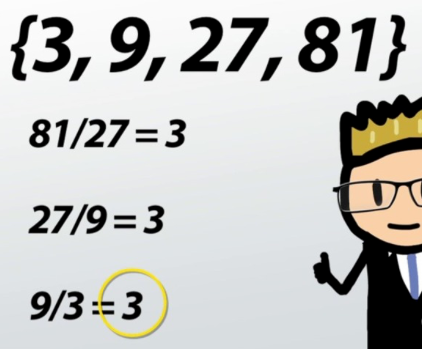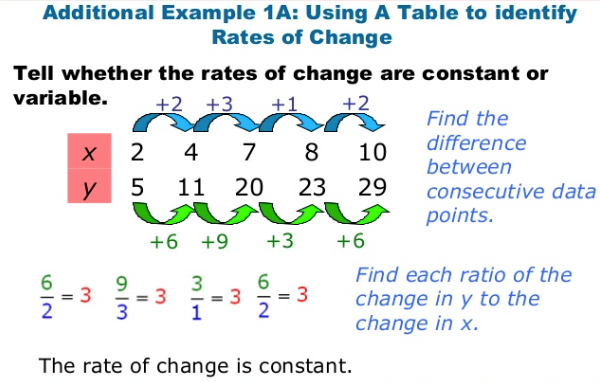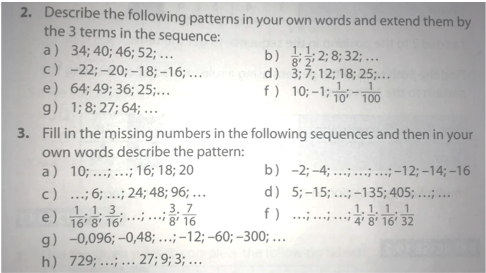Numeric and geometric patterns
Describing patterns
Constant difference and constant ratios
When given a number sequence, we can find the number pattern with a constant difference or a constant ratio.
A number sequence with a constant difference means we can either add or subtract the same number between two consecutive terms.
The following number pattern is given:
1; 4; 7; 11 .....
In the example we can see that from 1 to 4, we have to add 3. The numbers are increasing.
Therefore this is a number sequence with a constant difference of +3.
2; -3; -8; -13.........
In this example, the numbers are decreasing, we have to subtract 5 from 2 to get -3. The constant difference between each term is -5.
This example is a number sequence with a constant difference of -5.
In a geometric sequence we find a number pattern with a constant ratio.
This means that we can multiply or divide with the same number between two consecutive numbers.
2; 4; 8; 16; 32; 64.........
In the example above, the constant ratio is x2.
We have to multiply each number with 2 to get the next number in the pattern.
This example is a geometric sequence with a constant ratio of 2.
3; -9; 27; -81........
The ratio of the above example is x (-3).
From 3, to get -9, we multiply with -3. We multiply each number with -3 to get the next number in the sequence. Remember that a negative times a negative, gives a positive.
This is a geometric sequence with a ratio of -3.
We can ask learners to do the following activity.
1. Describe the following sequence by determining the constant difference or the constant ratio and state whether the sequence is numeric or geometric.
1.1) 1; 3; 5; 7; .............
Learners can start by asking themselves if the numbers are increasing or decreasing.
In this case the number are increasing, which means we either have to add or multiply.
Learners can see that if they have 1, and add 2, the answer will be 3. If they add another 2, the answer is 5 etc.
The constant difference for this sequence is +2 which means it is a numeric sequence.
1.2) -4; -44; -484; -5324;...........
First, ask yourself if the numbers are increasing or decreasing. The numbers are increasing, which means we either have to add or multiply. If we get the difference between 4 and 44, we see that it is 40, but the difference between 44 and 484 is not 40. This means we don't add. Now, we can only multiply a number to get the next number in the sequence.
- -4 x 11 =-44
- -44 x 11=-484
- -484 x 11=-5324
The constant ratio between the numbers are x (11) which means that this is a geometric sequence.
Activity 2 and 3
Conclusion
Make sure your learners know the difference between a numeric and geometric sequences.
Numeric sequences we only add and subtract to get the next answer.
Geometric sequences we multiply and divide to get the next answer.



